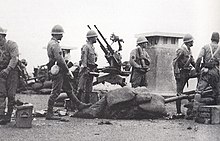
The Russian Naval Infantry, often referred to as Russian Marines in the West, operate as the naval infantry of the Russian Navy. Established in 1705, they are capable of conducting amphibious operations as well as operating as more traditional light infantry.

Minoru Ōta was an admiral in the Imperial Japanese Navy during World War II, and the final commander of the Japanese naval forces defending the Oroku Peninsula during the Battle of Okinawa.

The Invasion of the Kuril Islands was the World War II Soviet military operation to capture the Kuril Islands from Japan in 1945. The invasion, part of the Soviet–Japanese War, was decided on when plans to land on Hokkaido were abandoned. The successful military operations of the Red Army at Mutanchiang and during the invasion of South Sakhalin created the necessary prerequisites for invasion of the Kuril Islands.

The Special Naval Landing Forces were naval infantry units of the Imperial Japanese Navy (IJN) and were a part of the IJN Land Forces. They saw extensive service in the Second Sino-Japanese War and the Pacific theatre of World War II.

The Republic of China Marine Corps is the amphibious arm of the Republic of China Navy (ROCN) responsible for amphibious warfare, counter-landing and reinforcement of the areas under the jurisdiction of the Republic of China (ROC), including the island of Taiwan, Kinmen, and the Matsu Islands, and defense of ROCN facilities, also functioning as a rapid reaction force and a strategic reserve capable of amphibious assaults.

Keiji Shibazaki was a Rear Admiral in the Imperial Japanese Navy. He was the commander of the Japanese garrison on the island of Betio of the Tarawa atoll during World War II. Shibazaki and all his senior officers were killed by naval gunfire on the first day of the Battle of Tarawa. He was posthumously promoted to vice-admiral.

The Battle of Sihang Warehouse took place from October 26 to November 1, 1937, and marked the beginning of the end of the three-month Battle of Shanghai in the opening phase of the Second Sino-Japanese War. Defenders of the warehouse held out against numerous waves of Japanese forces and covered Chinese forces retreating west during the Battle of Shanghai.

The Ranks of the Imperial Japanese Navy were the rank insignia of the Imperial Japanese Navy, used from its creation in 1868, until its dissolution in 1945 following the Surrender of Japan in World War II. The ranks were inspired by the ranks of the Royal Navy.
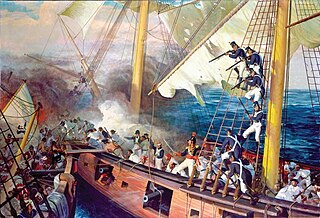
Marines, or naval infantry, are soldiers who specialise at operating in littoral zones, both on land and at sea. Historically, the main tasks undertaken by marines have included raiding ashore in support of naval objectives, and the boarding of vessels during combat or capture of prize ships. Marines also help maintain discipline and order aboard the ship. In most countries, marines are an integral part of that state's navy.
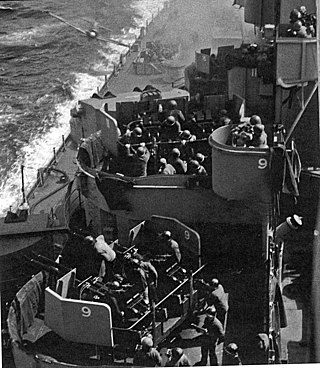
During World War II, Japanese Special Attack Units, also called shimbu-tai, were specialized units of the Imperial Japanese Navy and Imperial Japanese Army normally used for suicide missions. They included kamikaze aircraft, fukuryu frogmen, and several types of suicide boats and submarines.

The 1st Airborne Brigade, also known as the Narashino Airborne Brigade (習志野空挺団), is stationed in the Japan Ground Self-Defense Force (JGSDF) Camp Narashino in Funabashi, Chiba Prefecture.

The Ukrainian Marine Corps, also known simply as the Ukrainian Marines, is the maritime land force service branch of the Armed Forces of Ukraine since 2023, responsible for conducting expeditionary and amphibious operations. From its modern foundation in 1993 up to 2023 it constituted part of the Coastal Forces of the Ukrainian Navy. It is used as a component part of amphibious, airborne and amphibious-airborne operations, alone or in coordination with formations and units of the Ground Forces in order to capture parts of the seashore, islands, ports, fleet bases, coast airfields and other coast objects from the enemy. It can also be used to defend naval bases, vital shoreline areas, separate islands and coast objects, and security of hostile areas.
The United States Marine Corps's Advanced Base Force was a coastal and naval base defense force that was designed to set up mobile and fixed bases in the event of major landing operations within, and beyond, the territorial United States. Established in the beginning of the 20th century, the Advanced Base Force was the United States' first combined task force built on the concept of the Marine Corps' traditional role in expeditionary warfare. The slow development of the advanced base force played a significant role in the controversy over the removal of the ships' guards in 1908–1909.
Tokkeitai (特警隊) may refer to:
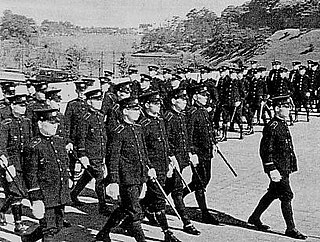
The Emergency Service Unit was a rapid reaction force of the Tokyo Metropolitan Police Department (TMPD) in the pre-World War II era. This unit were interpreted as a Japanese counterpart of the New York City Police Department Emergency Service Unit.
The Fourth Air Army was a land-based aviation force of the Imperial Japanese Army. Formed in Rabaul in June 1943, consisting of the 6th and 7th Air Divisions. The air army was responsible for covering the Solomon Islands, Dutch New Guinea and the Territories of Papua and New Guinea areas of operations. The headquarters was at Rabaul. Disestablished in January 1945.

The Soviet invasion of South Sakhalin, also known as the Battle of Sakhalin, was the Soviet invasion of the Japanese portion of Sakhalin Island known as Karafuto Prefecture. The invasion was part of the Soviet–Japanese War, a minor campaign in the Asian Theatre during Second World War.

Riot Police Unit are the rapid reaction forces of Japanese prefectural police. These units are not only riot police, but a type of emergency service unit to maintain public order against large civil disorder, disaster response, or other emergency situations as the key units of Japanese law enforcement for crisis management. They are operated by prefectural police headquarters (PPH) under the supervision of the Security Bureau of the National Police Agency.
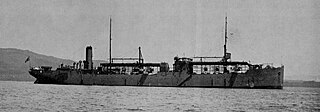
Notoro (能登呂) was an oiler of the Imperial Japanese Navy commissioned in 1920, which was rebuilt in 1924 into a seaplane tender and in 1941 back into an oiler. She participated in the First Shanghai Incident in 1932 and the Second Sino-Japanese War since 1937. In the fall of 1941, she was rebuilt back into an oiler. On 9 January and 20 September 1943, she was damaged by US Navy submarines but returned to service after repairs. On 29 June 1944, she was hit by two torpedoes launched by submarine USS Flasher. During repairs in Singapore Notoro was again damaged on 5 November 1944, this time by B-29 bombers. No further repairs were made until the end of the war and she was probably scrapped in 1947.

